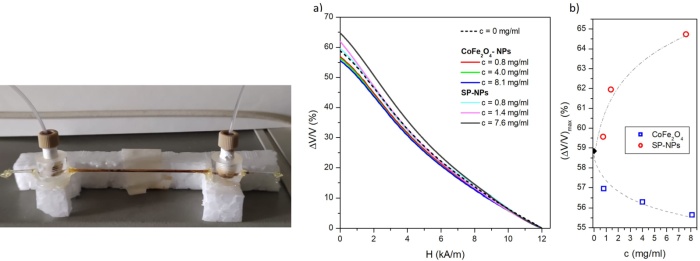Speaker
Description
Magnetic nanoparticles detection in fluid media is a promising technique for identifying biomolecules, antigens, pollutants, etc. that can be attached to their properly functionalised surface. Magnetic detection allows non-contact sensing, and many different effects, including magnetophoresis, magnetoresistance, magneto-impedance, optical and mechanical resonance ones can be exploited to address the specific problem and to achieve the desired sensitivities.
In this work, we aim at demonstrating the working principle of a magnetic nanoparticles detection system based on the giant magneto-impedance effect and exploiting a micro fluidic system. The experimental setup allows to control the flow (velocity, pressure) of a fluid into a micro-pipes system. A Fe$_{73.5}$Cu$_1$Nb$_3$Si$_{13.5}$B$_9$ microwire is inserted into a portion of the micro-pipes, with electrical contacts to inject an alternating current into the microwire (see Figure 1, left). An external solenoid provides a DC magnetic field directed parallel to the microwire axis. The fluid consists of water in which known concentrations of magnetic nanoparticles are dispersed: either CoFe$_2$O$_4$ nanoparticles synthesised by co-precipitation method, or Micromod Partikeltechnologie GmbH commercial multicore superparamagnetic iron-oxide nanoparticles (SPIONs).
The water-dispersed nanoparticles flow along the micro fluidic system passing nearby the magnetic microwire. Its magneto-impedance effect is measured at constant electrical current frequency (1.5 MHz), as a function of the DC magnetic field applied with the solenoid. The voltage drop across the microwire is measured and its maximum variation between 0 and 12 kA/m applied field is mapped as a function of nanoparticles type and concentration, as shown in Figure 1 (right). The reciprocal interaction of the nanoparticles with microwire domain configuration is responsible for the different evolution of the GMI with concentration, which increases for SPIONs particles and decreases for harder Co-ferrites. The physical phenomena will be discussed in details.

Fig. 1 Left: detail of the micro-pipes system with the magnetic microwire. Right: voltage drop across the microwire as a function of applied DC magnetic field, for different nanoparticles types and concentration, and as a function of concentration, for different nanoparticles types.
Acknowledgements
This work was partially funded by Italian Ministry for University and Research DM 737/2021.

